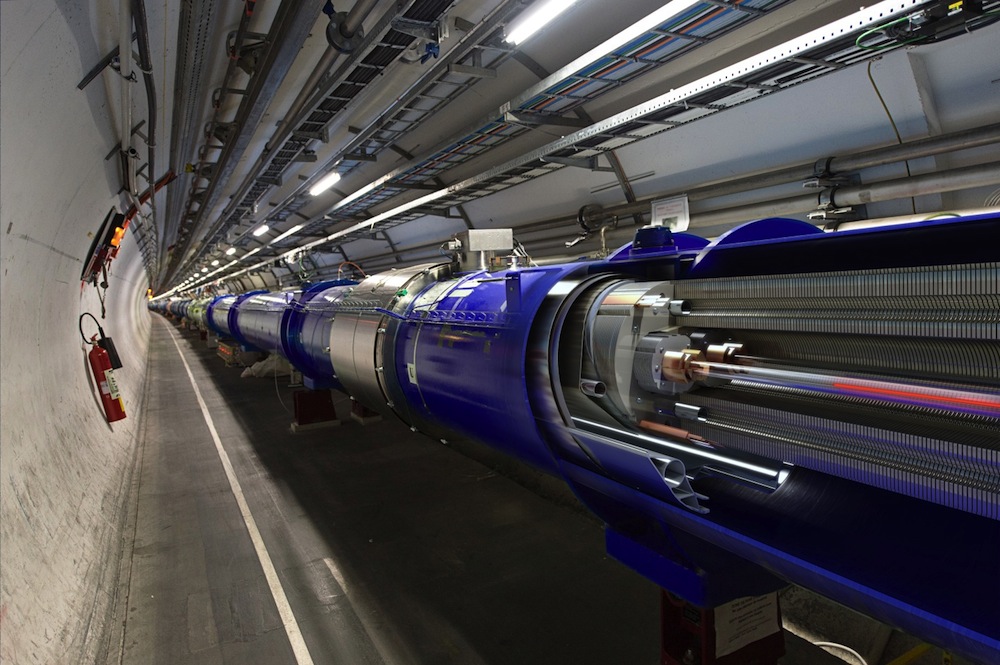The World's Most Powerful Atom Smasher Restarts With a Big Bang

The world's most powerful atom smasher, the Large Hadron Collider, which provides a window into the universe just milliseconds after the Big Bang, came back to life this morning, after more than two years of maintenance and upgrade work, and it's stronger than ever.
At 10:41 a.m. local time near Geneva, Switzerland (4:41 a.m. ET), a proton beam zipped around the 17-mile-long (27 kilometers) ring-shaped structure. Then at 12:27 p.m. Geneva time, another proton beam trekked around the ring in the opposite direction, officials at the European Organization for Nuclear Research (CERN) reported today (April 5).
In the first run of the restart, the LHC hit energies of 450 GeV, where one GeV is equivalent to the mass of a proton. In the coming days, LHC operators plan to amp up the energy of the proton beams to the highest ever achieved. [Photos: The World's Largest Atom Smasher (LHC)]
"After two years of effort, the LHC is in great shape," Frédérick Bordry, CERN director for accelerators and technology, said in a statement. "But the most important step is still to come when we increase the energy of the beams to new record levels."
The LHC is perhaps best known for its detection in 2012 of the long-sought Higgs boson particle, thought to explain how other particles get their mass. Inside the gigantic collider, two proton beams zip around at near light speed in opposite directions. When the two beams collide, various subatomic particles, some unknown to science, are produced. The collider relies on strong magnetic fields (created by superconducting electromagnets) to guide the proton beams; the electromagnets must be chilled to minus 456.3 degrees Fahrenheit (minus 271.3 degrees Celsius), colder than outer space, so they can conduct electricity without resistance or energy loss, according to CERN. Liquid helium helps to keep the system that cold.
The upgrade was a "Herculean task," according to the CERN statement. Teams of scientists consolidated 10,000 electrical interconnections between the magnets, added magnet protection systems and improved various other aspects of the giant collider. Protons will be bunched closer together in the beams inside the upgraded LHC, meaning more collisions.
The new-and-improved LHC will be more powerful than ever, smashing protons together at energies up to 13 trillion electron volts (TeV); for comparison, the atom smasher was running at 8 TeV when it detected the Higgs boson.
Sign up for the Live Science daily newsletter now
Get the world’s most fascinating discoveries delivered straight to your inbox.
Higher energies mean more chances of discovering the exotic particles the LHC was created to find.
"The Higgs discovery was one of the most important scientific achievements of our time," James Siegrist, the U.S. Department of Energy's associate director of science for high energy physics, said in a statement. "With the LHC operational again, at even higher energies, the possibilities for new discoveries are endless, and the United States will be at the forefront of those discoveries."
Beyond finding the Higgs boson, the LHC could produce particles predicted by a theory called supersymmetry that says every particle has a partner. These supersymmetric particles, or sparticles, in turn, could solve the mystery of dark matter, the invisible stuff in the universe that reveals itself only through its tug on normal matter.
With heavier proton beams, the LHC can recreate conditions that existed just a few billionths of a billionth of a billionth of a second after the universe was created. By studying these conditions, physicists hope to figure out why the universe is made mostly of matter and not antimatter.
About 10,000 people from 113 different countries, including seven U.S. DOE national labs and 90 U.S. universities, helped to design, build and upgrade the LHC.
Follow Jeanna Bryner on Twitter and Google+. Follow us @livescience, Facebook & Google+. Original article on Live Science.
Jeanna Bryner is managing editor of Scientific American. Previously she was editor in chief of Live Science and, prior to that, an editor at Scholastic's Science World magazine. Bryner has an English degree from Salisbury University, a master's degree in biogeochemistry and environmental sciences from the University of Maryland and a graduate science journalism degree from New York University. She has worked as a biologist in Florida, where she monitored wetlands and did field surveys for endangered species, including the gorgeous Florida Scrub Jay. She also received an ocean sciences journalism fellowship from the Woods Hole Oceanographic Institution. She is a firm believer that science is for everyone and that just about everything can be viewed through the lens of science.









